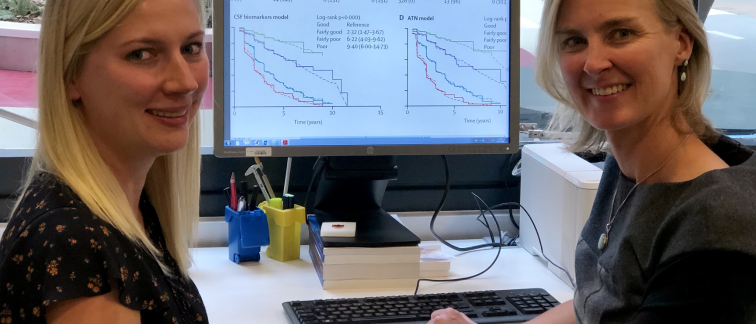Alzheimer Center Amsterdam investigator Ingrid van Maurik c.s. and Wiesje van der Flier, head of research for Neurodegeneration and program leader in Amsterdam Neuroscience aimed to establish robust prediction models of disease progression in people at risk of dementia and their modelling study published this week in the Lancet Neurology.
In this modelling study, they included people with mild cognitive impairment (MCI) from single-centre and multicentre cohorts in Europe and North America: the European Medical Information Framework for Alzheimer’s Disease (EMIF-AD; n=883), Alzheimer’s Disease Neuroimaging Initiative (ADNI; n=829), Amsterdam Dementia Cohort (ADC; n=666), and the Swedish BioFINDER study (n=233).
Inclusion criteria were a baseline diagnosis of MCI, at least 6 months of follow-up, and availability of a baseline Mini-Mental State Examination (MMSE) and MRI or CSF biomarker assessment. The primary endpoint was clinical progression to any type of dementia. Van Maurik c.s. evaluated performance of previously developed risk prediction models—a demographics model, a hippocampal volume model, and a CSF biomarkers model—by evaluating them across cohorts, incorporating different biomarker measurement methods, and determining prognostic performance with Harrell’s C statistic. Then they updated the models by re-estimating parameters with and without centre-specific effects and evaluated model calibration by comparing observed and expected survival. Finally, they constructed a model combining markers for amyloid deposition, tauopathy, and neurodegeneration (ATN), in accordance with the National Institute on Aging and Alzheimer’s Association research framework.
All 2611 individuals with MCI in the four cohorts, 1007 (39%) of whom progressed to dementia were included in this study. The validated demographics model (Harrell’s C 0·62, 95% CI 0·59–0·65), validated hippocampal volume model (0·67, 0·62–0·72), and updated CSF biomarkers model (0·72, 0·68–0·74) had adequate prognostic performance across cohorts and were well calibrated. The newly constructed ATN model had the highest performance (0·74, 0·71–0·76).
In the Lancet Neurology article risk models are described that are robust across cohorts, which adds to their potential clinical applicability. The models could aid clinicians in the interpretation of CSF biomarker and hippocampal volume results in individuals with MCI, and help research and clinical settings to prepare for a future of precision medicine in Alzheimer’s disease. Future research should focus on the clinical utility of the models, particularly if their use affects participants’ understanding, emotional wellbeing, and behaviour.
Read the publication in the Lancet Neurology 'Biomarker-based prognosis for people with mild cognitive impairment (ABIDE): a modelling study'.

